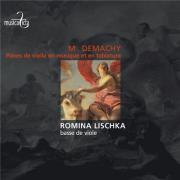Texte paru dans: / Appeared in: |
|
|
|
|
|
Reviewer: Barry
Brenesal Demachy’s suites may be chordal in nature, but he uses chords to furnish additional voices and rhythmic and harmonic support. Melody drives these works; and if they don’t touch the expressive depths of Marais, another Saint-Colombe student, they still fall gracefully upon the ear. Each of the four suites on the album has seven movements, following a pattern of prelude, allemande, courante, sarabande, gigue, gavotte, and minuet, except for the Suite in G Major that concludes with the lengthiest movement of all, a four-and-a-half-minute Chaconne. As envisioned by Demachy, each dance type has a set of characteristics in common, though dances within a given type may differ only slightly. Thus, the courantes offer training in three beats against two, the sarabandes in phrasing and the proper performance of ornaments, and the gigues in rhythmic precision and agility across the instrument’s expansive range. Romina Lischka has several recordings to her credit, though all prior to this were as part of ensembles, Le Jardin Secret, Scherzi Musicali, and Les Flamboyants among them. She switched from the guitar to the viol at the age of 13, studying in her 20s with Paolo Pandolfo and later with Philippe Pierlot. Here she displays a fine technique, excellent command of tone, and full awareness of style. Her ornaments flow naturally within the line, and her phrasing is fluid. She faces, however, competition from one of her teachers. Paolo Pandolfo has recorded four of the suites (Glossa 920413). Two of these, the Suite No. 1 in D Minor and the Suite No. 4 in G Major, are also present on this disc. Without getting into technicalities, two differences are apparent. First, Pandolfo plays the gigues (and to a lesser extent, the gavottes) at a much faster pace. He sacrifices nothing in the way of tone or accuracy in doing so. He further performs them with a more strongly pronounced accent on the second beat, and in general prefers to clarify the beat more distinctly than Lischka. This gives the faster pieces more lift, and the slower pieces more of a sense of movement towards or away from the cadence. Given a choice between the two, I prefer Pandolfo. However, there is nothing innately wrong with Lischka’s approach, and between the two, the number of Demachy’s suites on record swells with this album from four to six. Viol fanciers will want both. | |
|
|
|
|
Cliquez l'un ou l'autre
bouton pour découvrir bien d'autres critiques de CD |
|




